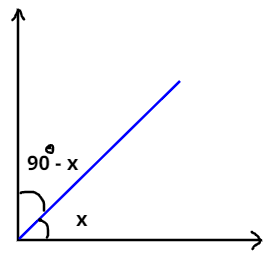
Find the angle which is equal to its complement:
Answer
608.7k+ views
Hint:- Sum of two complementary angles is \[{90^0}\]

As we all know that if \[\theta \] be an angle then,
Complement of \[\theta \] will be \[\left( {{{90}^0} - \theta } \right)\].
And the supplementary angle will be \[\left( {{{180}^0} - \theta } \right)\].
So, we can say that the sum of two complementary angles is equal to \[{90^0}\].
And the sum of two supplementary angles is equal to \[{180^0}\].
Let the angle which had to find be x.
Then its complementary angle would be \[\left( {{{90}^0} - x} \right)\].
As, given in the question that angle and its complementary angle will be equal. So,
\[ \Rightarrow x = \left( {{{90}^0} - x} \right)\] (1)
On, solving equation 1. We get,
\[ \Rightarrow 2x = {90^0}\]
\[ \Rightarrow x = {45^0}\]or \[x = \dfrac{\pi }{4}\]
Hence the angle which is equal to its complement will be \[{45^0}\].
Note:- Whenever we came up with this type of problem then easiest and efficient way is to
go with the definition of complementary angles or supplementary angles, whichever is required. And after finding angles in degree we can also change that into radian.

As we all know that if \[\theta \] be an angle then,
Complement of \[\theta \] will be \[\left( {{{90}^0} - \theta } \right)\].
And the supplementary angle will be \[\left( {{{180}^0} - \theta } \right)\].
So, we can say that the sum of two complementary angles is equal to \[{90^0}\].
And the sum of two supplementary angles is equal to \[{180^0}\].
Let the angle which had to find be x.
Then its complementary angle would be \[\left( {{{90}^0} - x} \right)\].
As, given in the question that angle and its complementary angle will be equal. So,
\[ \Rightarrow x = \left( {{{90}^0} - x} \right)\] (1)
On, solving equation 1. We get,
\[ \Rightarrow 2x = {90^0}\]
\[ \Rightarrow x = {45^0}\]or \[x = \dfrac{\pi }{4}\]
Hence the angle which is equal to its complement will be \[{45^0}\].
Note:- Whenever we came up with this type of problem then easiest and efficient way is to
go with the definition of complementary angles or supplementary angles, whichever is required. And after finding angles in degree we can also change that into radian.
Recently Updated Pages
Master Class 12 Economics: Engaging Questions & Answers for Success

Master Class 12 Maths: Engaging Questions & Answers for Success

Master Class 12 Biology: Engaging Questions & Answers for Success

Master Class 12 Physics: Engaging Questions & Answers for Success

Master Class 8 Maths: Engaging Questions & Answers for Success

Class 8 Question and Answer - Your Ultimate Solutions Guide

Trending doubts
Why is there a time difference of about 5 hours between class 10 social science CBSE

Write a letter to the principal requesting him to grant class 10 english CBSE

What is the median of the first 10 natural numbers class 10 maths CBSE

The Equation xxx + 2 is Satisfied when x is Equal to Class 10 Maths

Which of the following does not have a fundamental class 10 physics CBSE

State and prove converse of BPT Basic Proportionality class 10 maths CBSE




